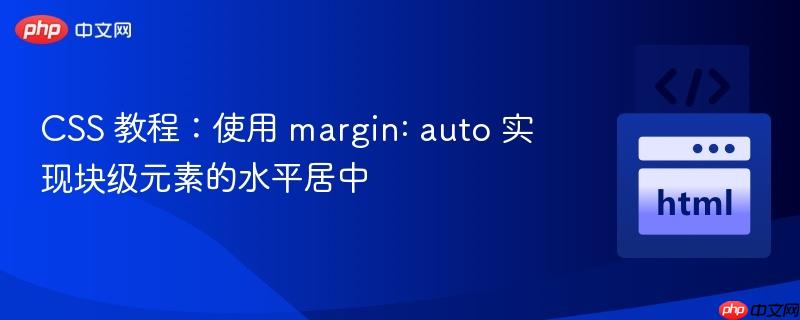
本教程详细讲解如何利用 css 中的 `margin: auto` 属性,轻松实现块级元素的水平居中。我们将通过实际代码示例,演示如何将带有背景图片的 `header` 元素及其内容精准定位到页面中心,并探讨该方法的适用条件与注意事项,帮助您掌握前端布局的核心技巧。
在网页布局中,将块级元素(如 div、header、section 等)水平居中是一个非常常见的需求。默认情况下,块级元素会占据其父容器的全部可用宽度,并从左侧开始排列。要将其水平居中,我们需要一种机制来平均分配其左右两侧的空白空间。
CSS 提供了一个简洁而强大的属性组合来实现块级元素的水平居中:margin-left: auto; 和 margin-right: auto;。通常,我们会将其简写为 margin: auto;。当一个块级元素设置了明确的宽度(width)并且其左右外边距被设置为 auto 时,浏览器会自动计算并分配左右两侧的剩余空间,使元素在其父容器中水平居中。
让我们看一个具体的例子。假设我们有一个 header 元素,它具有特定的尺寸、边框和背景图片,我们希望它在页面上水平居中显示。
原始 CSS 样式:
立即学习“前端免费学习笔记(深入)”;
header {
background-image: url('tiredBOX.jpg');
border: solid 3px orange;
height: 200px;
width: 200px; /* 关键:必须设置宽度 */
border-radius: 50%;
padding: 30px;
}
h1 {
text-align: center;
color: orange;
background-color: lightgrey;
border: dotted white 4px;
margin-right: 600px;
margin-left: 600px;
}
body {
background-color: teal;
}在上述代码中,header 元素虽然设置了 width,但它仍然会靠左显示。要使其水平居中,我们只需在 header 的样式中添加 margin: auto;。
添加 margin: auto 后的 CSS 样式:
header {
background-image: url('tiredBOX.jpg');
border: solid 3px orange;
height: 200px;
width: 200px;
border-radius: 50%;
padding: 30px;
margin: auto; /* 核心居中代码 */
}
h1 {
text-align: center;
color: orange;
background-color: lightgrey;
border: dotted white 4px;
/* h1的margin-left和margin-right设置了固定值,这会限制其宽度并可能导致布局问题,
如果需要h1也居中,且宽度自适应,则应移除固定margin或使用text-align: center */
margin-right: 600px;
margin-left: 600px;
}
body {
background-color: teal;
}工作原理:
当 margin-left 和 margin-right 都设置为 auto,并且元素具有明确的 width 时,浏览器会计算父容器的可用宽度减去元素的宽度,然后将剩余的宽度平均分配给左右外边距。这样,元素就自然地被推到了父容器的中心。
为了更好地演示,我们提供一个完整的 HTML 和 CSS 结构。
HTML (index.html):
<!DOCTYPE html>
<html lang="zh-CN">
<head>
<meta charset="UTF-8">
<meta name="viewport" content="width=device-width, initial-scale=1.0">
<title>CSS 块级元素水平居中示例</title>
<link rel="stylesheet" href="style.css">
</head>
<body>
<header>
<h1>Centered Header</h1>
</header>
</body>
</html>CSS (style.css):
body {
background-color: teal;
display: flex; /* 使用Flexbox来居中body内的h1,或者直接在h1上使用text-align */
justify-content: center;
align-items: center;
min-height: 100vh; /* 确保body至少占满视口高度 */
margin: 0; /* 移除body默认外边距 */
}
header {
background-image: url('tiredBOX.jpg'); /* 确保图片路径正确 */
background-size: cover; /* 使背景图片覆盖整个元素 */
background-position: center; /* 居中背景图片 */
border: solid 3px orange;
height: 200px;
width: 200px;
border-radius: 50%;
padding: 30px;
margin: auto; /* 核心:使header自身水平居中 */
display: flex; /* 使用Flexbox来居中header内的h1 */
justify-content: center;
align-items: center;
flex-direction: column; /* 如果有多个子元素需要垂直排列 */
}
h1 {
text-align: center; /* 确保h1文本内容居中 */
color: orange;
background-color: rgba(211, 211, 211, 0.7); /* 半透明背景 */
border: dotted white 4px;
padding: 10px 20px; /* 增加内边距 */
margin: 0; /* 移除h1默认外边距,让flexbox控制 */
max-width: 80%; /* 限制h1宽度,防止过宽 */
box-sizing: border-box; /* 边框和内边距包含在宽度内 */
}注意: 在上述示例中,为了更好地演示,我调整了 h1 的样式。原始 h1 的 margin-right: 600px; 和 margin-left: 600px; 会使其宽度非常小,并且不方便居中。如果 h1 只是文本,使用 text-align: center; 即可。如果 h1 作为一个块级元素需要在 header 内部居中,可以利用 header 的 Flexbox 布局特性。
margin: auto; 是 CSS 中实现块级元素水平居中布局的经典且高效的方法。通过为元素设置固定的 width 和 margin: auto;,可以确保元素在父容器中完美居中。理解其工作原理和适用条件,能够帮助开发者快速解决常见的布局问题,为更复杂的响应式设计打下坚实基础。在实际开发中,结合 background-position 等属性,可以实现元素及其内部背景的综合居中效果。
以上就是CSS 教程:使用 margin: auto 实现块级元素的水平居中的详细内容,更多请关注php中文网其它相关文章!

每个人都需要一台速度更快、更稳定的 PC。随着时间的推移,垃圾文件、旧注册表数据和不必要的后台进程会占用资源并降低性能。幸运的是,许多工具可以让 Windows 保持平稳运行。

Copyright 2014-2025 https://www.php.cn/ All Rights Reserved | php.cn | 湘ICP备2023035733号